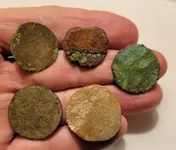D
Deleted member 140734
Guest
- #1
Thread Owner
Today I found the upper left and upper middle coppers from an area which was my region's first colonial settlement in 1650. In my hand is a collection of coin-like objects that I have found in this specific area within the past two years. They were all found in dry soil, isolates not associated with debris fields. The first Puritans that shifted into my area from CT colony probably didn't have much material wealth and practiced austere lifestyles. It's tough to find traces of them and I spend many long days searching. In the larger area I have found KG I, II, III along with Rosa Americana, clustered in iron nail fields, my earliest dates being 1723 and 1724. I jokingly refer to these coins as proto-currency. Metals hold up well in our well-drained soils and these appear to worn smooth from usage as opposed to in ground corrosion. The upper ones are quite thin. The upper middle almost appears to have a thin black coating with fine quartz grit applied, maybe not a coin but an abrasive tool. I believe the thick one in the lower right is a gold-silver alloy. It weighs exactly one troy ounce. That's how it came out of the ground around 4" deep.
Amazon Forum Fav 👍
Attachments
Upvote
5




